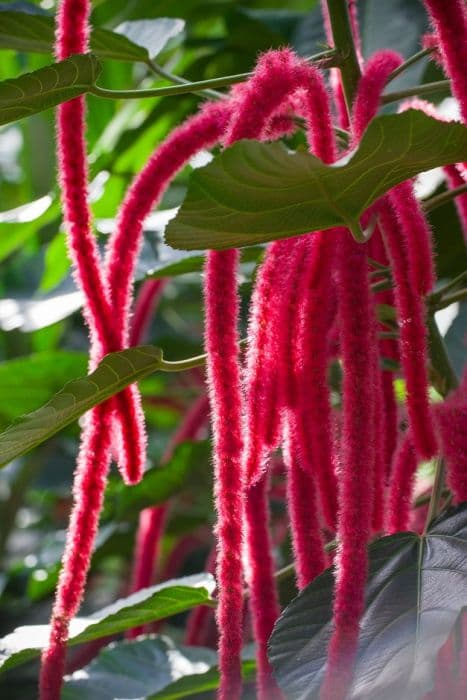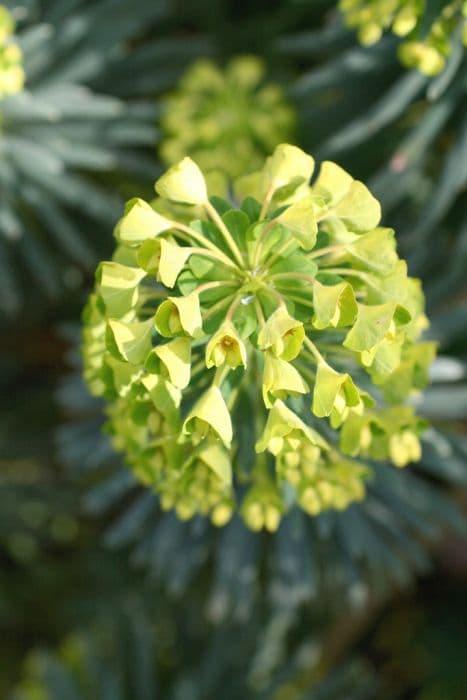Variegated croton Codiaeum variegatum var. pictum (v)



ABOUT
Codiaeum variegatum var. pictum (v) is an evergreen shrub that typically grows to a height of 3 to 5 feet tall, with a spread of 0.5 to 2 feet wide.
Its leaves are glossy, leathery, and are arranged in a variety of shapes, including lance-shaped, oval, or oblong. The color of the leaves is a mix of shades of creamy yellow, light green, dark green, pink, red, and orange. The edges of the leaves may be smooth or jagged. In summer, the plant produces white-yellow flowers up to 2 inches across.
The flowers are followed by small fruits that are filled with tiny yellow seeds. The texture of the foliage is waxy and multi-colored.
The overall appearance of the plant is an eye-catching array of vibrant colors that become even more striking when the sun strikes them.
About this plant
 Names
NamesFamily
Araliaceae
Synonyms
Fire croton, Garden croton, Croton, Sun-spot croton
Common names
Codiaeum elegans, Codiaeum chrysosticton, Codiaeum variegatum, Croton variegatus, Crozophyla variegata, Oxydectes variegata, Phyllaurea variegata
 Toxicity
ToxicityTo humans
Codiaeum variegatum var. pictum (v) is a plant that is toxic to humans if ingested. Symptoms of poisoning may include nausea, abdominal pain, vomiting, diarrhoea and confusion. In more severe cases, respiratory failure, coma and even death may occur. It is important to seek medical attention immediately if ingestion is suspected.
To pets
Codiaeum variegatum var. pictum (v) is toxic to animals if ingested. Symptoms of poisoning may include gastrointestinal irritation such as vomiting, abdominal pain and diarrhea. In severe cases, it can also cause convulsions, coma, decreased respiration and even death.
 Characteristics
CharacteristicsLife cycle
Perennials
Foliage type
Evergreen
Color of leaves
Variety of shapes
Flower color
White
Height
Up to 3 feet
Spread
Up to 2 feet
Plant type
Shrub
Hardiness zones
9
Native area
India
Benefits
 General Benefits
General BenefitsAir Purification: The Codiaeum variegatum var. pictum plant releases oxygen into the air, helping to remove toxins and purify the air in your home.
Aesthetically Pleasing: With its vibrant green, yellow and red leaves, this plant can be used to bring a splash of color to any living space.
Disease Resistant: This plant is highly resistant to pests and diseases and very unlikely to require intensive care.
Low Maintenance: The Codiaeum variegatum var. pictum requires very little maintenance, making it ideal for those with limited time.
Stress Relief: Studies have shown that having plants in your home can help reduce stress and anxiety levels. Medical Properties
Medical PropertiesThe plant is very poisonous. Do not use it as a treatment on its own and without consulting a doctor!
Anti-inflammatory: The active components and volatile oils found in Codiaeum variegatum var. pictum (v) have anti-inflammatory properties, which can help reduce redness, swelling, and discomfort associated with inflammatory conditions.
Antimicrobial: This plant contains a range of phytochemicals that can help inhibit the growth of harmful bacterial and fungal species, ultimately helping to protect the body from infection.
Digestive Aid: The active compounds in Codiaeum variegatum var. pictum (v) can help facilitate digestion, aiding with the breakdown and absorption of food components. This can help to prevent digestive issues such as bloating, gas, and stomach pain.
Liver Support: This plant has been shown to improve liver enzyme activity, supporting its overall health and function.
Urinary Tract Health: The plant's phytochemicals can help to protect the kidneys and urinary tract from infection and support their overall health.
Nerve Relaxant: Codiaeum variegatum var. pictum (v) has been found to have a calming effect on the central nervous system, reducing tension, stress and aiding relaxation.
Skin Health: This plant has moisturizing, anti-aging, and antioxidant properties which can help to protect the skin and give it a more youthful appearance. Air-purifying Qualities
Air-purifying QualitiesThe Codiaeum variegatum var. pictum is known for its air purifying qualities. It helps to filter out pollutants, including formaldehyde, toluene and xylene, from the atmosphere and to reduce indoor air pollution. The plant also helps to increase humidity levels, and can help reduce the presence of dust, mould spores, and even pet dander in the home. It is also known to be a natural insect repellent.
 Other Uses
Other UsesIndoor Privacy Screen: Codiaeum variegatum var. pictum plants can be used to create a natural privacy screen within the home, as their full foliage can create a fairly effective natural barrier.
Unique Color Palettes: The bright and bold colors of Codiaeum variegatum var. pictum make them a great option for adding a unique splash of color to any space.
Houseplant: Codiaeum variegatum var. pictum can easily adapt to most living environments, making them great indoor houseplants.
Ecological Obstruction: Codiaeum variegatum var. pictum plants can be used to divert wind and moisture away from vulnerable vegetation or homes, such as those in coastal areas.
Focal Point Piece: The bright and vivid colors of Codiaeum variegatum var. pictum can make them a great focal point piece in any home, as their unique foliage can draw the eye.
Interesting Facts
 Feng Shui
Feng ShuiCodiaeum variegatum var. pictum (v) can be used according to Feng Shui principles to bring wealth and abundance. Place a pot or a bonsai of this cheerful plant near the entrance of your house or office to attract wealth and create a welcoming atmosphere. Make sure to leave enough room for the tree to grow, as bigger plants attract more wealth. To further enhance the wealth luck potential, you can sprinkle coins around the plant or hang lucky charms on the branches.
 Plant Symbolism
Plant SymbolismCodiaeum variegatum has been used as a symbol of immortality, vitality, and rejuvenation.
The vivid colors of the Garden Croton represent the physical and mental landscape that a person experiences on their journey to seek truth and enlightenment.
The bright and dense foliage is a sign of the abundance of new possibilities and knowledge that come with striving for a richer inner world.
The large leaves bear symbolism of strength, courage, wisdom, and growth, encouraging one to keep growing in every way. The varied shapes, sizes and colors of the leaves represent the individual diversity of human experiences, allowing for personal growth and unique paths for each journeyer.
All of these elements come together to invoke the idea that with hard work and dedication, success, strength, and perspective can be gained.
 Water
WaterCodiaeum variegatum should ideally be watered when the soil surface feels dry to the touch. The amount of water needed will vary depending on the season and the size of the container, but typically a thorough watering is required every 7 to 10 days.
When watering, soak the soil until water runs out of the bottom of the pot. Use lukewarm water and avoid getting water on the leaves as it can cause leaf damage.
To prevent root rot and fungi, try to avoid over-watering and allowing the soil to remain soggy. Light
LightThe best light conditions for Codiaeum variegatum is bright, indirect sunlight.
 Temperature
TemperatureBest summer temperature conditions: 72-85°F.
Best winter temperature conditions: 65-75°F. Pruning
PruningCodiaeum variegatum should be pruned using sharp, clean pruning shears every two to three months, beginning in early spring and ending in late fall. Pruning should involve removing dead or damaged branches, as well as any branches that grow out of the desired shape of the plant. When pruning, take care to only remove one-third of the foliage, allowing for healthy growth over the remainder of the season. Additionally, to maintain an attractive shape, you may wish to selectively prune the top and sides to bring the desired shape.
 Soil
SoilThe best soil mix for Codiaeum variegatum var. pictum (v) consists of 2 parts peat moss, 2 parts loamy soil, and 1 part perlite. The soil mix should be well-aerated, quick draining, and slightly acidic, with a soil pH of 6.2-6.5.
 Humidity & Misting
Humidity & MistingThe best humidity for Codiaeum variegatum var. pictum is between 40% and 60%.
 Suitable locations
Suitable locationsIndoor
Not growing
Outdoor
All year round
Hardiness zone
10 - 12 USDA
 Life cycle
Life cycleThe life of Codiaeum variegatum begins with the germination of its seeds. The seeds are sown in a warm, moist potting mix and typically germinate in two to four weeks.
After germination, the seedling stage begins. During this stage, the plant develops its first leaves and begins to grow.
In the vegetative growth stage, the plant grows rapidly, producing new leaves and stems. This stage can last for several months to a year.
Codiaeum variegatum produces small, insignificant flowers that are usually hidden by the foliage. Flowering typically occurs during the summer months.
After flowering, Codiaeum variegatum may produce small, berry-like fruit that contains one or two seeds.
odiaeum variegatum can grow up to 6 feet tall and wide when mature. At this stage, the plant produces an abundance of leaves and may require pruning to maintain its shape.
Like all plants, Codiaeum variegatum will eventually decline and die. However, with proper care, the plant can live for several years. Propogation
PropogationPropogation time
Spring - summer
Stem Cuttings:
Stem cuttings of the Codiaeum variegatum var. pictum (v) should be taken in the springtime when temperatures have warmed to a range of between 70-80 degrees Fahrenheit. The cuttings should be about 4-6 inches long and have at least one node and some green foliage. Make sure that the cutting is taken from the tip of the stem and that the bottom of the cutting has at least one node. Place the cuttings in a pot filled with moist potting mix, lightlywater and provide bright indirect light. Once the stem cutting is rooted in soil, transfer the new plant to a larger pot.
Stem Division:
When the Codiaeum variegatum var. pictum (v) plant is root-bound, division can be used to multiply the plant. Divide the root ball of a larger pot-bound Codiaeum variegatum var. pictum (v) into two to four new plants. Don’t be too hard on the roots. Work slowly and carefully with your hands or a sharp knife to divide the plant. Once the division is completed, repot the new plants in separate pots with moist potting mix. Place the new plants in a warm and sunny location with temperatures ranging from 70-80 degrees Fahrenheit.
Seed:
Seeds for the Codiaeum variegatum var. pictum (v) should be started indoors in the wintertime. Start the seeds in a pot filled with a moist and well-draining potting mix. Place the pot in an area where temperatures range from 70-80 degrees Fahrenheit and provide bright, indirect light. Once the seeds begin to sprout and grow, move the pot to a sunny location and ensure that the soil remains moist. Once the seedlings are large enough, transplant them outside or into a larger pot.
 Pests
PestsSpider mite, Scale insects
 Diseases
DiseasesRoot Rot, Leaf spot
![Poinsettia [Jester Red]](/_next/image?url=https%3A%2F%2Fplants-admin.emdemapps.com%2Fimages%2Fplants%2F%2Fimages%2F604b55de5eb2c.png&w=640&q=75)








